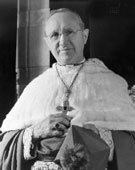See St. Louis Appointed July 20, 1946 Name Joseph Ritter Consecration March 28, 1933 | Rank Cardinal-Priest Ordination May 30, 1917 Term ended June 10, 1967 | |
 | ||
Other posts Cardinal-Priest of Santissimo Redentore e Sant'Alfonso in Via Merulan Born July 20, 1892New Albany, Indiana ( 1892-07-20 ) Died June 10, 1967, St. Louis, Missouri, United States | ||
Ritter's Jewellers Port Elizabeth South Africa - Africa Travel Channel
Joseph Elmer Ritter (July 20, 1892 – June 10, 1967) was an American prelate of the Roman Catholic Church. He served as Archbishop of St. Louis from 1946 until his death in 1967, and was created a cardinal in 1961. He previously served as auxiliary bishop (1933–34) and bishop (later archbishop) (1934–46) of Indianapolis. Ritter was one of the cardinals elector who participated at the Papal Conclave,1963.
Contents
- Ritters Jewellers Port Elizabeth South Africa Africa Travel Channel
- Early life and education
- Priesthood
- Indianapolis
- St Louis
- Legacy
- References
Early life and education
Joseph Ritter was born in New Albany, Indiana, one of six children of Nicholas and Bertha (née Luette) Ritter. His father worked as a baker, and his mother was of German lineage. He received his early education at the parochial school of St. Mary's Church in New Albany. During the seventh grade, Ritter decided to enter the priesthood, later saying, "There was no vision, no voice from heaven. I simply wanted to be a priest." In 1907, he enrolled at St. Meinrad's Seminary in southern Indiana, where he completed his studies in 1917.
Priesthood
On May 30, 1917, Ritter was ordained a priest by Bishop Joseph Chartrand at St. Meinrad Archabbey. His first assignment was as a curate at St. Patrick's Church in Indianapolis. Shortly afterwards, he was transferred to Saints Peter and Paul Cathedral, also in Indianapolis. He later served as rector of the cathedral from 1920 to 1933. In 1922, he received an honorary doctorate of theology from Pope Pius XI.
Indianapolis
On February 3, 1933, Ritter was appointed auxiliary bishop of the Diocese of Indianapolis and titular bishop of Hippos by Pius XI. He received his episcopal consecration on the following March 28 from Bishop Chartrand, with Bishops Alphonse John Smith and Emmanuel Boleslaus Ledvina serving as co-consecrators. At age 40, he was one of the youngest Catholic bishops in the United States. As an auxiliary bishop, he also served as vicar general of the diocese from 1933 to 1934.
Following the death of Bishop Chartrand, Ritter was appointed the seventh Bishop of Indianapolis on March 24, 1934. In 1938, he ordered an end to racial segregation in all Catholic schools in the diocese. His decision, made 16 years before Brown v. Board of Education, was met with opposition by the Ku Klux Klan, whose members protested outside of SS. Peter and Paul Cathedral, and even by his fellow members of the clergy. Also during his tenure, Ritter reorganized the diocesan Catholic Charities, introduced the Catholic Youth Organization, and completed the construction of SS. Peter and Paul Cathedral. He reduced the diocese's debt by $3 million.
The Diocese of Indianapolis was elevated to the status of an archdiocese by Pope Pius XII on October 21, 1944, and Ritter was installed as its first Archbishop on December 19, 1944.
St. Louis
Ritter was appointed the fourth Archbishop of St. Louis, Missouri, by Pius XII on July 20, 1946, succeeding the late Cardinal John J. Glennon. In 1947, as one of his first acts as archbishop, Ritter announced an end to racial segregation in all Catholic schools before the fall term. He declared, "The cross on top of our schools must mean something," and expressed his belief in "the equality of every soul before Almighty God." In response, a group of over 700 white Catholics threatened to sue Ritter on the basis that his directive was contrary to state law. Ritter then issued a pastoral letter in which he warned that any Catholic who brought him to court would incur excommunication; the group subsequently decided to take no action against him. He also desegregated all Catholic hospitals in the archdiocese.
Ritter also forbade Catholics to see The French Line under danger of serious sin, and declared that Catholics must have written permission from the archdiocese to attend secular or non-Catholic colleges. He was one of the first bishops to create a diocesan mission, specifically in La Paz, Bolivia. Until that time, most missions had been conducted by Roman Catholic religious institutes or societies of apostolic life. The people of Saint Louis regularly contributed more money to these foreign missions than any archdiocese of its size. He served as president of the National Catholic Educational Association from 1955 to 1956, and was named an Assistant at the Pontifical Throne on October 5, 1956.
Ritter was created Cardinal Priest of SS. Redentore e S. Alfonso in Via Merulana by Pope John XXIII in the consistory of January 16, 1961. Between 1962 and 1965, he participated in all four sessions of the Second Vatican Council in Rome. Ritter was viewed as a liberal. He also protested against the Roman Curia's oppressive actions and Cardinal Alfredo Ottaviani's draft on the sources of Revelation at the Council. On his return to Saint Louis, many Catholics expected him to make several changes to the existing administrative structure to give priests and laity a greater role in Church governance, as recommended by the Council. However, before he could implement such reforms, Ritter died from a heart attack at age 74, one month and ten days short of his next birthday.
